Subhankar Roy
FedMVP: Federated Multi-modal Visual Prompt Tuning for Vision-Language Models
Apr 29, 2025Abstract:Textual prompt tuning adapts Vision-Language Models (e.g., CLIP) in federated learning by tuning lightweight input tokens (or prompts) on local client data, while keeping network weights frozen. Post training, only the prompts are shared by the clients with the central server for aggregation. However, textual prompt tuning often struggles with overfitting to known concepts and may be overly reliant on memorized text features, limiting its adaptability to unseen concepts. To address this limitation, we propose Federated Multimodal Visual Prompt Tuning (FedMVP) that conditions the prompts on comprehensive contextual information -- image-conditioned features and textual attribute features of a class -- that is multimodal in nature. At the core of FedMVP is a PromptFormer module that synergistically aligns textual and visual features through cross-attention, enabling richer contexual integration. The dynamically generated multimodal visual prompts are then input to the frozen vision encoder of CLIP, and trained with a combination of CLIP similarity loss and a consistency loss. Extensive evaluation on 20 datasets spanning three generalization settings demonstrates that FedMVP not only preserves performance on in-distribution classes and domains, but also displays higher generalizability to unseen classes and domains when compared to state-of-the-art methods. Codes will be released upon acceptance.
Group-robust Machine Unlearning
Mar 12, 2025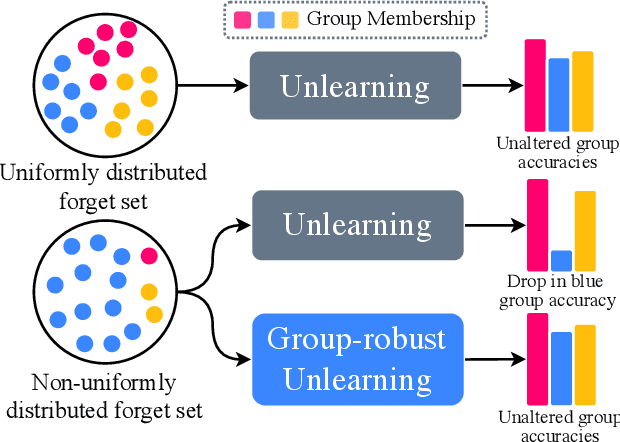

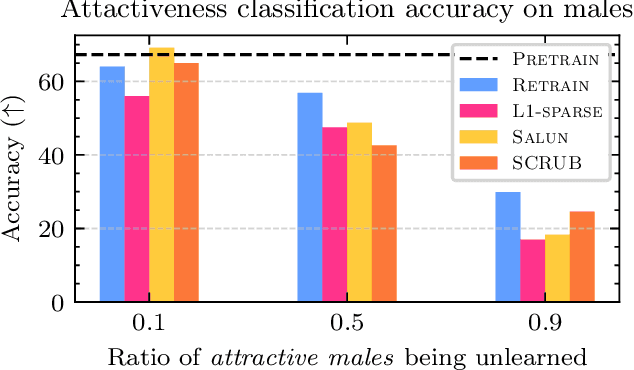

Abstract:Machine unlearning is an emerging paradigm to remove the influence of specific training data (i.e., the forget set) from a model while preserving its knowledge of the rest of the data (i.e., the retain set). Previous approaches assume the forget data to be uniformly distributed from all training datapoints. However, if the data to unlearn is dominant in one group, we empirically show that performance for this group degrades, leading to fairness issues. This work tackles the overlooked problem of non-uniformly distributed forget sets, which we call group-robust machine unlearning, by presenting a simple, effective strategy that mitigates the performance loss in dominant groups via sample distribution reweighting. Moreover, we present MIU (Mutual Information-aware Machine Unlearning), the first approach for group robustness in approximate machine unlearning. MIU minimizes the mutual information between model features and group information, achieving unlearning while reducing performance degradation in the dominant group of the forget set. Additionally, MIU exploits sample distribution reweighting and mutual information calibration with the original model to preserve group robustness. We conduct experiments on three datasets and show that MIU outperforms standard methods, achieving unlearning without compromising model robustness. Source code available at https://github.com/tdemin16/group-robust_machine_unlearning.
Organizing Unstructured Image Collections using Natural Language
Oct 07, 2024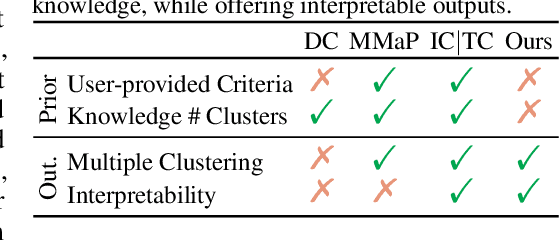


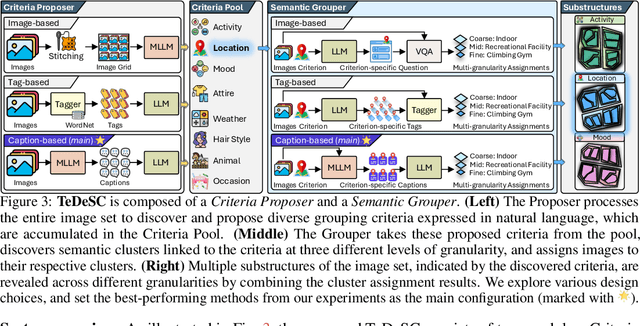
Abstract:Organizing unstructured visual data into semantic clusters is a key challenge in computer vision. Traditional deep clustering (DC) approaches focus on a single partition of data, while multiple clustering (MC) methods address this limitation by uncovering distinct clustering solutions. The rise of large language models (LLMs) and multimodal LLMs (MLLMs) has enhanced MC by allowing users to define clustering criteria in natural language. However, manually specifying criteria for large datasets is impractical. In this work, we introduce the task Semantic Multiple Clustering (SMC) that aims to automatically discover clustering criteria from large image collections, uncovering interpretable substructures without requiring human input. Our framework, Text Driven Semantic Multiple Clustering (TeDeSC), uses text as a proxy to concurrently reason over large image collections, discover partitioning criteria, expressed in natural language, and reveal semantic substructures. To evaluate TeDeSC, we introduce the COCO-4c and Food-4c benchmarks, each containing four grouping criteria and ground-truth annotations. We apply TeDeSC to various applications, such as discovering biases and analyzing social media image popularity, demonstrating its utility as a tool for automatically organizing image collections and revealing novel insights.
One-Shot Unlearning of Personal Identities
Jul 16, 2024
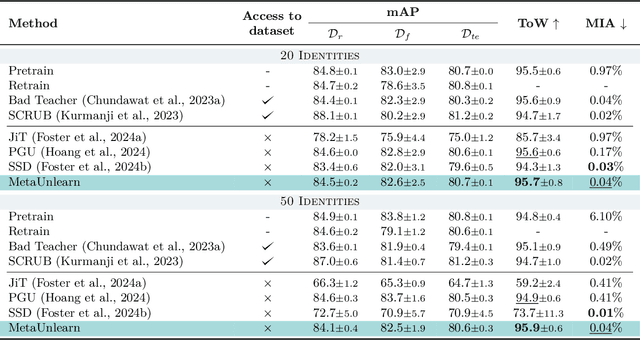
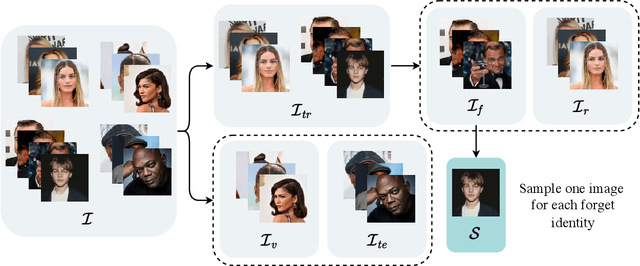
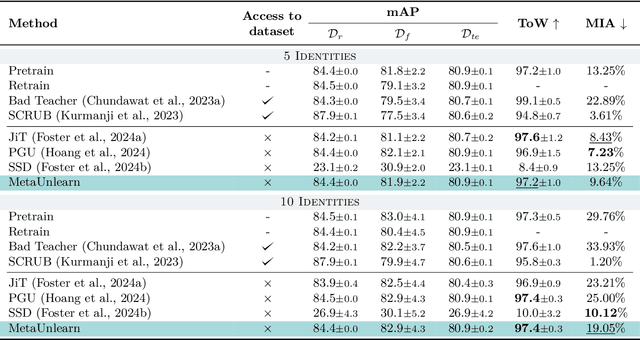
Abstract:Machine unlearning (MU) aims to erase data from a model as if it never saw them during training. To this extent, existing MU approaches assume complete or partial access to the training data, which can be limited over time due to privacy regulations. However, no setting or benchmark exists to probe the effectiveness of MU methods in such scenarios, i.e. when training data is missing. To fill this gap, we propose a novel task we call One-Shot Unlearning of Personal Identities (O-UPI) that evaluates unlearning models when the training data is not accessible. Specifically, we focus on the identity unlearning case, which is relevant due to current regulations requiring data deletion after training. To cope with data absence, we expect users to provide a portraiting picture to perform unlearning. To evaluate methods in O-UPI, we benchmark the forgetting on CelebA and CelebA-HQ datasets with different unlearning set sizes. We test applicable methods on this challenging benchmark, proposing also an effective method that meta-learns to forget identities from a single image. Our findings indicate that existing approaches struggle when data availability is limited, with greater difficulty when there is dissimilarity between provided samples and data used at training time. We will release the code and benchmark upon acceptance.
Less is more: Summarizing Patch Tokens for efficient Multi-Label Class-Incremental Learning
May 24, 2024Abstract:Prompt tuning has emerged as an effective rehearsal-free technique for class-incremental learning (CIL) that learns a tiny set of task-specific parameters (or prompts) to instruct a pre-trained transformer to learn on a sequence of tasks. Albeit effective, prompt tuning methods do not lend well in the multi-label class incremental learning (MLCIL) scenario (where an image contains multiple foreground classes) due to the ambiguity in selecting the correct prompt(s) corresponding to different foreground objects belonging to multiple tasks. To circumvent this issue we propose to eliminate the prompt selection mechanism by maintaining task-specific pathways, which allow us to learn representations that do not interact with the ones from the other tasks. Since independent pathways in truly incremental scenarios will result in an explosion of computation due to the quadratically complex multi-head self-attention (MSA) operation in prompt tuning, we propose to reduce the original patch token embeddings into summarized tokens. Prompt tuning is then applied to these fewer summarized tokens to compute the final representation. Our proposed method Multi-Label class incremental learning via summarising pAtch tokeN Embeddings (MULTI-LANE) enables learning disentangled task-specific representations in MLCIL while ensuring fast inference. We conduct experiments in common benchmarks and demonstrate that our MULTI-LANE achieves a new state-of-the-art in MLCIL. Additionally, we show that MULTI-LANE is also competitive in the CIL setting. Source code available at https://github.com/tdemin16/multi-lane
Democratizing Fine-grained Visual Recognition with Large Language Models
Jan 24, 2024



Abstract:Identifying subordinate-level categories from images is a longstanding task in computer vision and is referred to as fine-grained visual recognition (FGVR). It has tremendous significance in real-world applications since an average layperson does not excel at differentiating species of birds or mushrooms due to subtle differences among the species. A major bottleneck in developing FGVR systems is caused by the need of high-quality paired expert annotations. To circumvent the need of expert knowledge we propose Fine-grained Semantic Category Reasoning (FineR) that internally leverages the world knowledge of large language models (LLMs) as a proxy in order to reason about fine-grained category names. In detail, to bridge the modality gap between images and LLM, we extract part-level visual attributes from images as text and feed that information to a LLM. Based on the visual attributes and its internal world knowledge the LLM reasons about the subordinate-level category names. Our training-free FineR outperforms several state-of-the-art FGVR and language and vision assistant models and shows promise in working in the wild and in new domains where gathering expert annotation is arduous.
Collaborating Foundation models for Domain Generalized Semantic Segmentation
Dec 15, 2023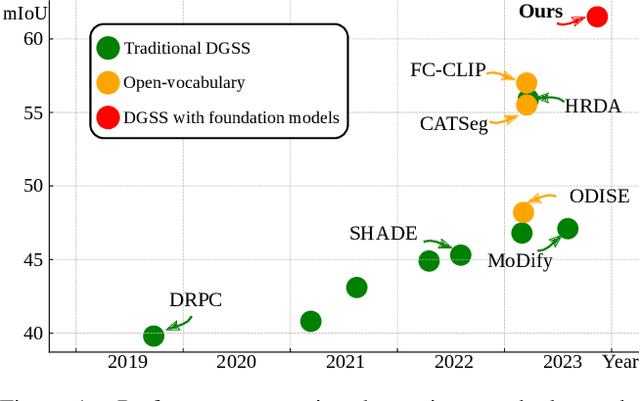
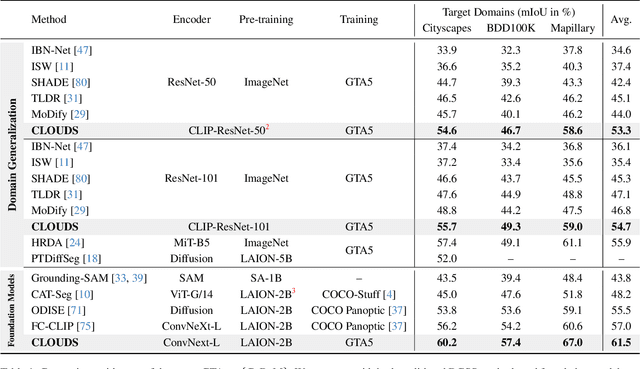

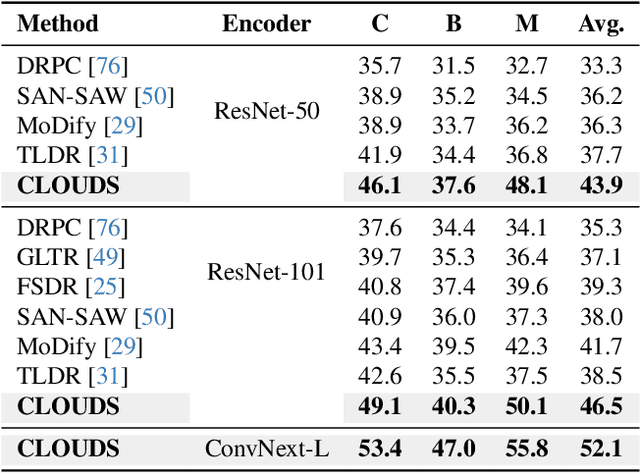
Abstract:Domain Generalized Semantic Segmentation (DGSS) deals with training a model on a labeled source domain with the aim of generalizing to unseen domains during inference. Existing DGSS methods typically effectuate robust features by means of Domain Randomization (DR). Such an approach is often limited as it can only account for style diversification and not content. In this work, we take an orthogonal approach to DGSS and propose to use an assembly of CoLlaborative FOUndation models for Domain Generalized Semantic Segmentation (CLOUDS). In detail, CLOUDS is a framework that integrates FMs of various kinds: (i) CLIP backbone for its robust feature representation, (ii) generative models to diversify the content, thereby covering various modes of the possible target distribution, and (iii) Segment Anything Model (SAM) for iteratively refining the predictions of the segmentation model. Extensive experiments show that our CLOUDS excels in adapting from synthetic to real DGSS benchmarks and under varying weather conditions, notably outperforming prior methods by 5.6% and 6.7% on averaged miou, respectively. The code is available at : https://github.com/yasserben/CLOUDS
Weighted Ensemble Models Are Strong Continual Learners
Dec 14, 2023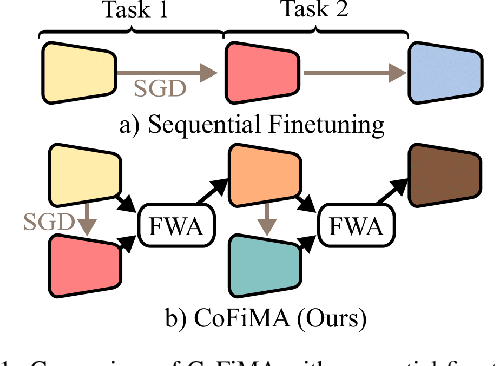
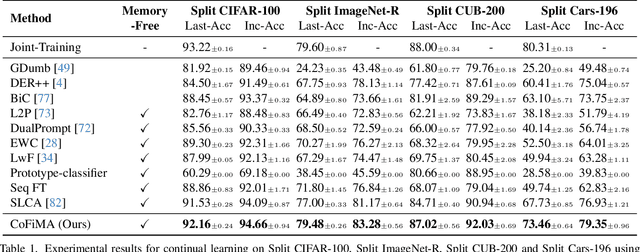

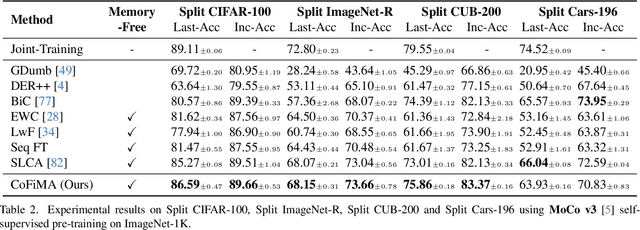
Abstract:In this work, we study the problem of continual learning (CL) where the goal is to learn a model on a sequence of tasks, such that the data from the previous tasks becomes unavailable while learning on the current task data. CL is essentially a balancing act between being able to learn on the new task (i.e., plasticity) and maintaining the performance on the previously learned concepts (i.e., stability). With an aim to address the stability-plasticity trade-off, we propose to perform weight-ensembling of the model parameters of the previous and current task. This weight-ensembled model, which we call Continual Model Averaging (or CoMA), attains high accuracy on the current task by leveraging plasticity, while not deviating too far from the previous weight configuration, ensuring stability. We also propose an improved variant of CoMA, named Continual Fisher-weighted Model Averaging (or CoFiMA), that selectively weighs each parameter in the weight ensemble by leveraging the Fisher information of the weights of the model. Both the variants are conceptually simple, easy to implement, and effective in attaining state-of-the-art performance on several standard CL benchmarks.
Rethinking Class-incremental Learning in the Era of Large Pre-trained Models via Test-Time Adaptation
Oct 17, 2023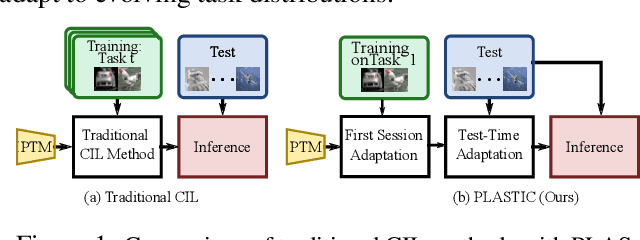
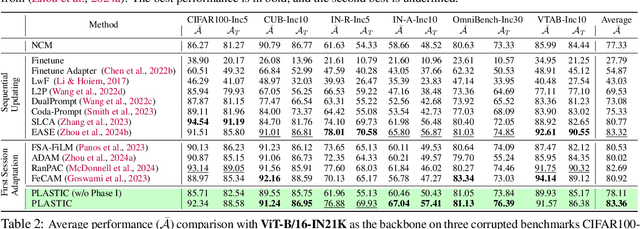


Abstract:Class-incremental learning (CIL) is a challenging task that involves continually learning to categorize classes into new tasks without forgetting previously learned information. The advent of the large pre-trained models (PTMs) has fast-tracked the progress in CIL due to the highly transferable PTM representations, where tuning a small set of parameters results in state-of-the-art performance when compared with the traditional CIL methods that are trained from scratch. However, repeated fine-tuning on each task destroys the rich representations of the PTMs and further leads to forgetting previous tasks. To strike a balance between the stability and plasticity of PTMs for CIL, we propose a novel perspective of eliminating training on every new task and instead performing test-time adaptation (TTA) directly on the test instances. Concretely, we propose "Test-Time Adaptation for Class-Incremental Learning" (TTACIL) that first fine-tunes Layer Norm parameters of the PTM on each test instance for learning task-specific features, and then resets them back to the base model to preserve stability. As a consequence, TTACIL does not undergo any forgetting, while benefiting each task with the rich PTM features. Additionally, by design, our method is robust to common data corruptions. Our TTACIL outperforms several state-of-the-art CIL methods when evaluated on multiple CIL benchmarks under both clean and corrupted data.
The Unreasonable Effectiveness of Large Language-Vision Models for Source-free Video Domain Adaptation
Aug 22, 2023Abstract:Source-Free Video Unsupervised Domain Adaptation (SFVUDA) task consists in adapting an action recognition model, trained on a labelled source dataset, to an unlabelled target dataset, without accessing the actual source data. The previous approaches have attempted to address SFVUDA by leveraging self-supervision (e.g., enforcing temporal consistency) derived from the target data itself. In this work, we take an orthogonal approach by exploiting "web-supervision" from Large Language-Vision Models (LLVMs), driven by the rationale that LLVMs contain a rich world prior surprisingly robust to domain-shift. We showcase the unreasonable effectiveness of integrating LLVMs for SFVUDA by devising an intuitive and parameter-efficient method, which we name Domain Adaptation with Large Language-Vision models (DALL-V), that distills the world prior and complementary source model information into a student network tailored for the target. Despite the simplicity, DALL-V achieves significant improvement over state-of-the-art SFVUDA methods.
 Add to Chrome
Add to Chrome Add to Firefox
Add to Firefox Add to Edge
Add to Edge